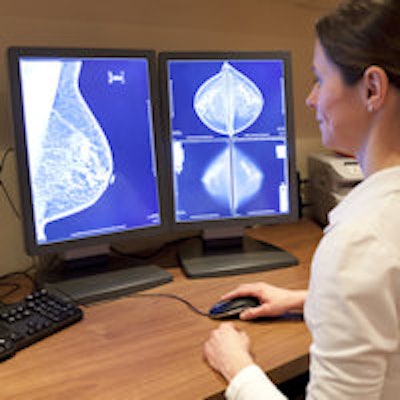
About half of U.S. states have laws that require women to be notified if they have dense breast tissue -- and counseled to discuss supplemental screening. But are BI-RADS breast density assessments consistent among radiologists? Not so much, according to a study published online July 18 in the Annals of Internal Medicine.
 Brian Sprague, PhD, from the University of Vermont.
Brian Sprague, PhD, from the University of Vermont.
It's not the fact that these assessments vary that's surprising but the range of variation, lead author Brian Sprague, PhD, of the University of Vermont told AuntMinnie.com. And these differences have implications for states considering density reporting laws and also for the clinical management of women who are told they have dense breasts.
"At one end of our sample, there were radiologists who rated only 6% of the mammograms they read as dense, while at the other end, there were radiologists who rated 84% of the mammograms they read as dense," he said. "We've always known that there's interobserver variability, but our results show that it's bigger than we anticipated."
Dense -- or not?
Sprague and colleagues collected data from 30 radiology facilities within the three breast cancer screening research centers of the Population-based Research Optimizing Screening through Personalized Regimens (PROSPR) consortium, an effort funded by the U.S. National Cancer Institute (NCI). The study included more than 215,000 mammograms acquired between 2011 and 2013 in Massachusetts, New Hampshire, Pennsylvania, and Vermont (before density notification laws were enacted in these states). A total of 83 radiologists interpreted the exams (Ann Int Med, July 18, 2016).
Overall, 36.9% of the mammograms were rated as showing dense breast tissue, either heterogeneously or extremely dense (BI-RADS 3 and 4). But actual classifications were all over the map and varied greatly among sites participating in the study. The greatest range was at the University of Vermont, where some radiologists only classified 6.3% of cases as BI-RADS 3 or 4, while others classified 84.5% in the two high-density categories.
Even more confusing for patients is that among women with consecutive mammograms interpreted by different radiologists, more than a third (32.6%) had a different density assessment at the two exams, with the most common changes from the "heterogeneously dense" category to the "scattered fibroglandular" classification, or vice versa. Sprague's group also found that 27% of women with dense breasts at their first exam were categorized as nondense at the second, and 11.4% of women with nondense breasts at the first exam were categorized as dense at the second.
Now what?
The widespread enactment of breast density notification laws presents physicians with the challenge of discussing the potential benefits and harms of supplemental breast screening in the absence of consensus guidelines, Sprague and colleagues wrote. If a woman's likelihood of being told she has dense breasts is so dependent on which radiologist interprets her mammogram, how can this variation gap be addressed?
First, policymakers need to be aware that breast density assessments vary widely, according to the group.
"Density reporting laws that suggest consideration of supplemental screening for women with dense breasts should include language acknowledging that density is a subjective measure," the researchers wrote.
Next, women and their primary care providers need to take a bigger picture regarding breast cancer risk, Sprague said.
"Density is one piece of the puzzle when it comes to determining breast cancer risk -- and it's a subjective one," Sprague said. "Women and their doctors need to take breast density into account when deciding how often to screen and whether to make use of supplemental screening, but also consider other risk factors."
Finally, for radiology, the question is whether to consider putting standardized breast density tools into place; several automated software programs have been developed for this purpose, according to Sprague.
"With breast density as a risk factor in the public eye, especially since so many states have passed notification laws, radiologists need to consider whether it's time to move toward more quantitative density tools," he said.




















